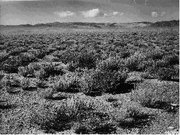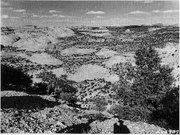Intermountain Semidesert and Desert Province
Contents
Intermountain Semidesert and Desert Province (Bailey)
Nevada, Utah, 107,100 mi2 (277,400 km2)
Land-surface form
The Intermountain Desert Province covers the physiographic section called the Great Basin and the northern Colorado Plateau in Utah. Much of this area is made up of separate interior basins; only a small part of it drains to the sea. The lower parts of many basins have heavy accumulations of alkaline and saline salts. Streams are rare and few are permanent. Many mountains rise steeply from the semiarid, sagebrush-covered plains. These mountains are generally well covered by vegetation, and their upper elevations usually bear sparse conifer forests.
Climate
Summers are hot, but winters are only moderately cold. The average annual temperature ranges from 40 to 55°F (4 to 13°C). Spring comes early, except at higher elevations. Annual precipitation averages only 5 to 20 in (130 to 490 mm), often falling as winter snow. Almost no rain falls during the summer months except in the mountains.
Vegetation
Sagebrush dominates at lower elevations. Other important plants in the sagebrush belt are antelope bitterbrush, shadscale, fourwing saltbush, rubber rabbitbrush, spiny hopsage, horsebrush, and short-statured Gambel oak. All these shrubs tolerate alkali to varying degrees, essential to their survival on the poorly drained soils widespread in the region. On soils with the highest concentrations of salt, even these shrubs are unable to grow; they are replaced by plant communities dominated by greasewood or saltgrass.
Although sagebrush now dominates this zone, it may not represent climax growth, but rather a disclimax produced by overgrazing. In plots protected from fire, grasses typical of the Palouse grassland or mixed-grass steppe gradually become dominant.
Above the sagebrush belt lies a woodland zone dominated by pinyon pine and juniper, similar to the pinyon-juniper woodland of the Colorado Plateau.
In the montane belt above the woodland zone, ponderosa pine generally occupies the lower and more exposed slopes and Douglas-fir the higher and more sheltered ones. In the subalpine belt, the characteristic trees are subalpine fir and Engelmann spruce. Only a few mountains rise high enough to support an alpine belt.
Soils
Aridisols dominate all basin and lowland areas; forest soils are found at higher elevations. Narrow bands of Entisols lie in stream floodplains and rocky landscapes. Salt flats and playas without soils are extensive in the lower parts of basins with interior drainage.
Fauna
Few large mammals live in this province, but mule deer, mountain lion, bobcat, and badger occasionally venture into it. Sagebrush provides ideal habitat for pronghorn antelope and whitetail prairie dog. The most common species are such small mammals as ground squirrels, jackrabbits, kangaroo mice, wood rats, and kit foxes. In the lower life belts, some ground squirrels--especially the Belding and Townsend ground squirrels--become dormant during the hot, dry summer.
Bird species range from the burrowing owl to such specialized species as sage sparrow and sage thrasher, both found only in sagebrush habitat. Raptors include the American kestrel and golden eagle, along with the ferruginous hawk and various other species of western hawks. In early spring, groups of sage grouse engage in elaborate courtship displays.
Return to Ecoregions of the United States
| Disclaimer: This article is taken wholly from, or contains information that was originally published by, the United States Forest Service. Topic editors and authors for the Encyclopedia of Earth may have edited its content or added new information. The use of information from the United States Forest Service should not be construed as support for or endorsement by that organization for any new information added by EoE personnel, or for any editing of the original content. |

